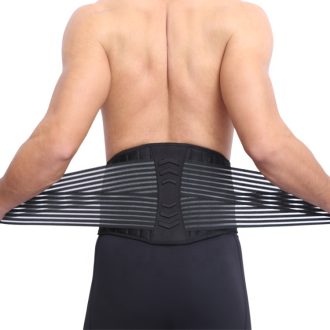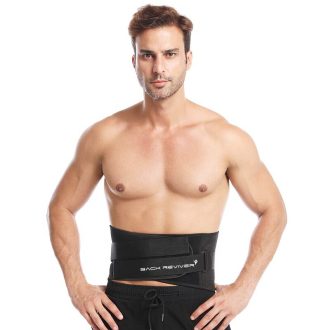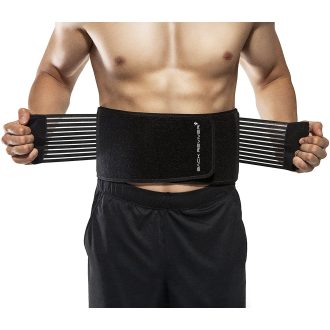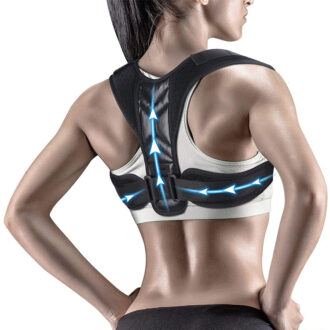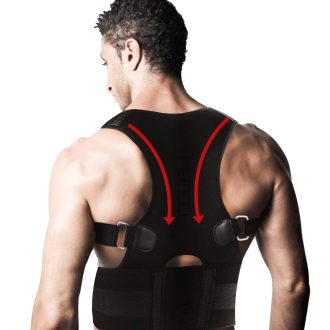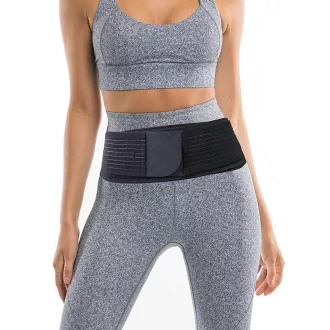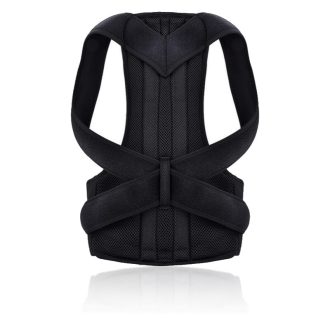No products in the cart.
Back Support braces
NuovaHealth back braces that support better posture and help ease day‑to‑day strain
Back discomfort can build when posture slips, tasks repeat, or hours of sitting or standing stack up. The NuovaHealth range brings together our own thoughtfully designed braces and trusted brands such as BackReviver, giving you practical options that guide a more upright stance, limit pain‑triggering movements, and add a gentle, reassuring hold. Research suggests that targeted support worn at the right times can reduce strain by improving alignment and spreading load, which helps everyday movements feel steadier. With sizes for most adults and low‑profile designs that sit smoothly under clothing, the NuovaHealth range aims to balance dependable support with day‑to‑day comfort.
Why posture matters and how a brace helps
Good posture shares load across the spine bones (vertebrae), discs, joints, and supporting muscles, so no single area works overtime. Evidence indicates that when posture drifts—slumped sitting, deep repeated bending, or over‑arching—pressure spikes in certain tissues and muscles tire as they try to guard. A well‑fitted NuovaHealth brace can help by gently encouraging a more upright position, limiting extreme motion where it tends to provoke symptoms, and adding light, even compression that improves body awareness (proprioception) and comfort. Reviews of studies report that short, activity‑focused wear is often most effective, especially when paired with regular movement and simple mobility work. The result is support you can feel when you need it—without relying on a brace all day.
How NuovaHealth braces support everyday movement
Across the range, you’ll find practical features that aim to support without getting in your way. Many designs include flexible stays and shaped panels that guide a comfortable, fairly straight posture, which helps reduce deep flexion and over‑arching that often flare symptoms. Even, adjustable compression around the trunk adds steady support and can make it easier to notice and correct slouching sooner. Dual‑pull strap systems on many models let you fine‑tune from both sides in seconds—go a touch firmer for standing, reaching, or light carrying; loosen slightly for seated work. Users often report that this combination keeps movement in a calmer range and spreads pressure more evenly, so common tasks feel steadier across the day. BackReviver options within the NuovaHealth range follow these principles, giving you more ways to find your preferred fit and feel.
When a brace may help—and for whom
Evidence indicates that a brace can help during flare‑ups, on busier days, and for tasks that tend to trigger discomfort—long standing, desk work, repeated reaching, light DIY, or chores. If you live with disc‑related low‑back ache, facet‑joint irritation, or age‑related changes, guiding posture and limiting pain‑triggering movements may ease day‑to‑day strain while you stay active. A NuovaHealth brace can also support confidence when you return to activity after a setback. Clinical guidance supports using braces as an add‑on to a broader plan rather than a stand‑alone fix, and results vary. If you’re unsure whether a brace is right for you, speak with a healthcare professional; they can identify what’s driving your symptoms and when a brace may fit within your plan.
Why choose NuovaHealth
Once you understand how and when a brace helps, choosing the right one becomes simpler. NuovaHealth curates a focused selection—our own designs plus multiple options from BackReviver—so you can pick with confidence. Designs are informed by clinical guidance and real‑world feedback, using durable, breathable fabric, smooth closures, and supportive elements to balance hold with ease. Evidence indicates that a well‑fitted brace can help reduce slouching and limit pain‑triggering movements during daily tasks; results vary and no brace can guarantee relief. To keep your choice low‑risk, purchases across the NuovaHealth range are covered by a 30‑day money‑back guarantee (fair‑use policy applies), so you can try a brace in your routine and see how it feels in real life.
How to use a back brace for best results
Research suggests building wear time gradually helps tissues adapt. Start with 30–60 minutes during your most demanding task, then add a little each day. Tighten to even support you can breathe and move in; adjust the side pulls when you stand to work or carry, then loosen slightly for seated breaks. Keep movement breaks and light mobility in your day so muscles stay engaged. Reviews of studies report that focusing wear on periods of activity tends to work better than wearing a brace all day, which supports comfort without letting muscles switch off. In practice, this approach helps you feel supported when it counts while maintaining strength and flexibility over time.
Common back issues where a brace may help
Back braces are often used as part of conservative care for a range of back problems. Evidence indicates they can support posture, limit pain‑triggering movements, and add reassuring compression, which may help day‑to‑day comfort while you stay active. Open the summaries below for plain explanations of common issues, who they tend to affect, typical signs, and how a brace may help alongside broader care.
Important information: sizing, fit, wear and care, and safety
Choose a style based on where you need support—upper back, lower back, or full back—and measure at the level the brace is designed to sit. For lower‑ or full‑back designs, measure around your waist at navel level. For upper‑back posture designs, measure around the upper chest, across the front and under the arms. If you fall between sizes, a smaller size usually gives firmer support and a larger size a gentler wrap; for upper‑back designs, consider shoulder breadth to keep straps comfortable. Refer to the product’s size guidance across the NuovaHealth range, including options from BackReviver.
Fit the brace so it gently encourages good posture without forcing it. For lower‑ or full‑back designs, centre the back panel, close the main fastening at a comfortable snugness, then tighten any side pulls evenly from left and right. For upper‑back designs, lay the straps flat, adjust to open the chest lightly without pulling the shoulders back hard, and make sure you can breathe and move your arms freely. In all cases, aim for even support you can talk and breathe in normally, with no pinching or pressure points; smooth out any wrinkles to reduce rubbing.
Build wear time gradually—start with 30–60 minutes during the task you find most demanding, then add a little each day. Focus use on periods of activity rather than wearing a brace all day, and keep regular movement breaks so muscles stay engaged. A light clothing layer under the brace can improve comfort. Follow the care label on your specific product; in general, fasten closures before washing, use cool, gentle cleaning, and air‑dry away from direct heat to protect supportive elements.
Use braces responsibly. Loosen or remove the brace if you notice numbness, tingling, unusual skin irritation, or worsening pain. Some designs in the NuovaHealth and BackReviver ranges include built‑in magnets that some users find soothing; do not use magnetic features if you have an implanted electronic or magnetic device, and avoid use during pregnancy. If you have osteoporosis or have recently had surgery, or if you’re unsure which style or size is right, seek advice before wearing.
Disclaimer and care advice
Back braces are designed to support posture and comfort during everyday tasks; they do not diagnose, treat, cure, or prevent disease. Evidence indicates they can help reduce day‑to‑day strain when used for short, activity‑focused periods alongside regular movement and a broader care plan. Seek prompt assessment if pain is severe or persistent, follows a fall, spreads to one or both legs with weakness or numbness, affects bowel or bladder control, or is accompanied by fever or unexplained weight change. Persistent, unexplained back pain can sometimes be a sign of a serious condition, so timely review matters. If you have osteoporosis, recent surgery, or any implanted electronic or magnetic device—or if you are pregnant—discuss brace use with a clinician first. If you’re unsure which NuovaHealth brace or size is right for you, our customer support team can help you find a good fit.
Next step
Explore the NuovaHealth range—featuring our own designs and multiple options from BackReviver—choose your size with confidence, and try a brace in your routine. Your purchase is covered by our 30‑day money‑back guarantee (fair‑use policy applies), so you can focus on how the support feels in everyday life.
Posture Trainer Corrector Back Brace for Upper Back, Shoulder Clavicle & Neck Support
- 1x Posture Trainer Corrector Back Brace designed to help improve your posture and train the muscle memory in your back, shoulders and neck with lasting improvements to posture seen after just 14 days of use
- For both Men & Women
- One sizes fits most (Features fully adjustable straps that allow you to change the level of support and compression the back brace provides)
- Designed to pin your shoulders back and support your clavicle, neck and upper back in the correct position to prevent slouching, hunching forward, rounded shoulders and forward neck to train and improve your posture
- Recommended for treating and easing a range of of different injuries affecting your upper body including Frozen shoulder, Spinal Stenosis, Clavicle fractures, Slipped disc, Facet syndrome and neck and shoulders strains and sprains
- Provides soothing compression to help ease aches and pains, reduce inflammation and swelling and prevent muscle fatigue and strain
- Ideal for runners, athletes and sports professionals wanting to improve their posture and form and protect their upper body from injury
- Made from lightweight, breathable Neoprene material with moisture wicking and antibacterial properties that kill germs and bacteria and keep your back dry and feeling fresh and comfortable
- Features comfortable Shoulder pads that prevent the shoulder straps from digging in and rubbing against your body
- Includes a full 30 day money back guarantee!
£12.99inc VATLower Back Brace Support Belt For Sciatica, Scoliosis, Slipped Disc, Herniated Disc, Back Pain Relief & Heavy Lifting
- 1x Lower back brace Support Belt specially designed by BackReviver™ to support, compress and protect your back
- For both Men & Women
- Available in the following waist sizes:
Medium – 2.1-2.4 feet or 25.2 Inches – 28.8 Inches
Large – 2.4-2.7 feet or 28.8 Inches – 32.4 Inches
Extra Large 2.7-3 feet or 32.4 Inches – 36 Inches - Features two fully adjustable straps that wrap around your lower back helping keep the brace securely in place whilst allowing you to quickly and easily adjust the support, compression and fit to suit your specific needs
- Recommended for helping to ease a number of lower back injuries and conditions including Sciatica, Scoliosis, Slipped Disc, Herniated Disc, Degenerative disc disease, Facet syndrome, Lumbar spinal stenosis, Spondylolisthesis, Muscle or ligament strain as well as Arthritis and Osteoarthritis
- Provides compression that boosts blood flow to your lower back helping to ease aches and pain, reduce inflammation and swelling and supply fresh oxygenated blood to damaged tissue helping to speed up the healing process of injuries
- Designed to help support and realign your lower back, stomach and hips to improve your posture, ease strain and pressure off your spine and prevent back injuries from occurring
- Inbuilt aluminium support rods help to protect your back by stabilizing and holding your lower back in the correct position to prevent movement which could twist and strain your injured back
- Features a padded inside that will help to keep your lower back and stomach comfortable whilst protecting you from shocks and jolts which could damage your back
- Ideal for wearing at the gym whilst exercising or when lifting heavy objects to improve your form and posture – Helps protect your back when lifting heavy objects by straightening your spine forcing you to lift from your legs more stopping you from putting pressure on your back
- Made from soft padded materials with moisture wicking properties to keep your back dry, sweat free and feeling comfortable when wearing the brace for long periods of time
- Includes a full 30 day money back guarantee!
£16.99inc VATLower Back Pain Brace for Sciatica, Slipped & Herniated Disc, Spinal Stenosis & Scoliosis
- 1x Lower Back Pain Brace designed by BackReviver™ to support and ease your lower back
- For both Men & Women
- Available in a range of different sizes
- Waist Measurements:
Medium – 2.1-2.4 feet or 25.2 Inches – 28.8 Inches
Large – 2.4-2.7 feet or 28.8 Inches – 32.4 Inches
Extra Large 2.7-3 feet or 32.4 Inches – 36 Inches
XXL 3-3.6 feet or 36 Inches – 43.2 inches
XXXL 3.6-4.2 feet or 43.2 Inches to 50.4 inches - Recommended for helping ease and treat Sciatica, Slipped & Herniated Disc, Spinal Stenosis, Scoliosis, Spondylolysis, Muscle or ligament strains, Muscle spasms, Arthritis, Osteoarthritis and more!
- Protects and supports your hips and lower back in the correct positioning helping to improve posture and ease strain and pressure off your spine protecting your back from further damage and whilst you recover
- Targeted compression relives aches and pains deep within your lower back and increases blood flow to your lower torso helping to reduce inflammation and swelling and speed up the healing process of injuries
- Features flexible inbuilt metal support rods that help prevent movement which could twist, sprain and cause damage to your lower back
- Fully adjustable dual straps wrap around your lower back allowing you to quickly change the level of support and compression as well as help keep the brace secure and stopping it from moving around and rubbing against your body whilst you wear it
- The perfect choice for wearing whilst exercising, playing sports or for general daily activities to help give your back extra support and protection against injury
- Made from premium quality materials that are lightweight, non-bulky breathable and have moisture wicking properties to help keep you dry and feeling fresher for longer
- Includes a full 30-day money back guarantee for total customer of peace of mind!
£21.99inc VATLower Back Support Brace
- 1x Lower Back Support Brace designed by BackReviver™ to help ease lower back pain and injuries
- For both Men & Women
- Available in a range of different waist sizes:
- Medium – 2.1-2.4 feet or 25.2 Inches – 28.8 Inches
Large – 2.4-2.7 feet or 28.8 Inches – 32.4 Inches
Extra Large 2.7-3 feet or 32.4 Inches – 36 Inches - Recommended for people suffering from herniated or slipped discs, Sciatica, Scoliosis, Spondylolysis, Muscle or ligament strains, Muscle spasms, Arthritis, Osteoarthritis and more!
- Improves your overall posture by realigning your hips and spine and supporting your lower back in the correct position helping to relieve pressure and prevent further damage and injury to your back
- Provides soothing compression that increases blood flow to your lower back ideal for reducing swelling and inflammation, easing soreness and pain and for boosting and speeding up the natural healing process of injuries
- Features inbuilt support rods that have been strategically placed to help increase stability and support and hold your back in the correct position to prevent movement which could cause twisting, straining and consequent damage to your back
- Fully adjustable Velcro straps hold the brace securely in place preventing it from moving around rubbing against your body and causing uncomfortable chaffing
- Made from premium medical grade materials that are lightweight, non bulky, breathable and with moisture wicking capabilities to help keep you dry, sweat free and feeling fresher for longer whilst you wear the brace
- Ideal for sports use and wearing whilst working out to promote better form and posture to protect your back from injuries
- Includes a full 30 day money back guarantee!
£16.99inc VATPosture brace
- 1x Back support posture corrector brace designed to improve posture and support and ease shoulder, neck and upper back pain
- For both men and women
- One size fits all featuring fully adjustable straps that hold the posture brace securely in place
- Lightweight and discreet design means it can be worn underneath regular clothing without excess bulk
- Quick and easily to wear. Simply put the posture corrector like a backpack
- Designed to help Improve your overall posture by realigning your spine and shoulders and preventing into the correct position and preventing common posture problems such as slouching, hunching forward, sway back, thoracic kyphosis, lumbar lordosis, rounded shoulders and forward head
- Helps ease pressure off your back and prevents and eases common back, neck and shoulder injuries
- Perfect for wearing for long periods. Made from high quality, durable soft padded material that provides extra protection, support and comfort and stops the posture brace from digging into your body whilst wearing for long periods
- Moisture wicking technology helps draw sweat away from your body and keep you feeling fresh and sweat free
- Ideal for general everyday use and wearing whilst playing sports or running
- Includes a full 30 day money back guarantee if you are not 100% satisfied with your purchase!
£9.99£14.99inc VATPelvic Support Belt
- 1x Pelvic Support Belt designed to ease hip and lower back pain and provide extra Lumbar Stability and support where you need it the most
- For both Men & Women
- One size fits most (maximum width of the belt 96cm at full stretch) – Features easy to use fully adjustable Velcro straps that wrap around your hips providing you with a custom level of support, and compression
- Stabilizes and supports your Lower Spine and pelvis in the correct position helping to ease pressure and strain off your hips and lower back
- Recommended for Pelvis Instabilities, Sacroiliac SI Joint pain, Sciatica, Herniated Disc & Post-partum recovery
- Great for promoting healing and better injury recovery – The soothing compression helps boost blood flow to your lower back and hips helping speed up the natural healing process, reduce inflammation and swelling and ease pain
- The comfortable and breathable design means this Pelvic Support Belt can be worn discreetly underneath your clothing and is the perfect choice for all day wearing or for wearing whilst exercising, running or playing sports
- Includes a full 30 day money back guarantee if you are not 100% satisfied with your purchase!
£11.99inc VATBack Straightener Brace
- 1x Back Straightener Support Brace designed to realign and straighten your back helping to promote better posture and prevent lower and upper back pain and injury
- For both Men and Women
- Available in a range of different sizes with fully adjustable straps which allow you to quickly and easily adjust the size and fitting of the brace to suit your body type
- Recommended for easing lower and upper back pain as well as easing a range of different back conditions and injuries including Sciatica, Slipped disc, Facet syndrome, Lumbar spinal stenosis, spine kyphosis and osteoporosis
- Actively works to prevent the most common causes of bad posture such as Rounded shoulders and slouching by properly supporting your shoulders, neck, ribcage, lower and upper back and helping you stand straighter with more confidence
- Features 2 supportive rods built into the brace that help support your upper and lower back in the correct position and help reduce pressure off your spine
- Made from lightweight padded material that is extremely comfortable and wont dig into your body
- The breathable holes provide excellent air ventilation to keep you dry, sweat free and feeling fresher for longer whilst wearing the back straightener
- Ideal for wearing whilst at the Gym, Running, playing sports or carrying out your daily activities
- Includes a full 30 day money back guarantee, if you are not 100% satisfied with your purchase!
- Available in sizes Small, Medium, Large, XL & XXL, 3XL and 4XL with two easy to use adjustable straps help you find the right support and fit for you.
- The maximum length of the belt are as follows measuring below the rib cage and around the stomach area (note this is adjustable downwards):
- M (Max length 100cm (39.37 inches)), L ( Max Length 102cm (40.15 inches)), XL (Max Length 104cm (40.9 inches)), 2XL (Max Length 106cm (41.7 inches)), 3XL (Max Length 108cm (42.5 inches)), 4XL (Max Length 110cm (43.3inches))
- Or if you don’t have your measurements generally the following weight guidelines can be used:
- M: up to 37.5kg
L:40-50kg
XL: 45-55kg
XXL:55-65kg
XXXL: 65-75kg
XXXXL: 75-80kg
£15.99inc VAT


